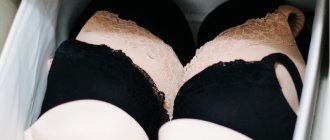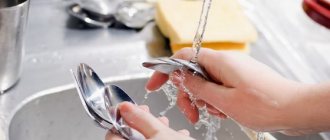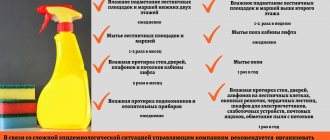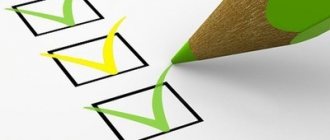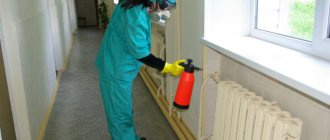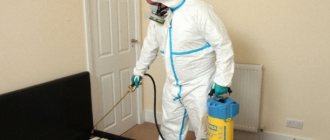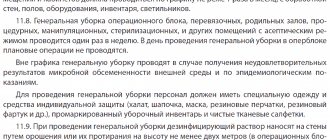Photobank Lori
According to SanPiN requirements, all cleaning equipment must be marked with certain colors, taking into account the types of cleaning work and the functional purpose of the room. It should also be stored in a specially designated room. In this case, a color-coded scheme should be placed in the inventory storage area.
Why is marking needed?
Labeling of cleaning equipment according to SanPiN, an example of which is given below, is mandatory for medical institutions, industrial premises, schools, kindergartens, catering establishments and other institutions. Its main purpose is to prevent cross-contamination and pathogenic contamination during harvesting. This is achieved through careful distribution of inventory into separate zones.
Today, the main regulatory document regulating the procedure for marking equipment for cleaning, storage and the rules for using equipment is Resolution of the Chief Physician of the Russian Federation dated 05/18/2010 58 (modified 06/10/2016) “On approval of SanPiN 2.1.3.2630-ten”. The document was developed for medical institutions, but from the point of view of maintaining a sanitary inventory, its provisions are applicable to any area.
SanPiN does not have clear instructions on what color of marking should be used in a particular territory. It only states the requirement that all cleaning equipment must be clearly marked or color coded (clause 11.5 of SanPiN). Organizations have the right to independently develop a color coding system, and the following colors are often used: red, blue, yellow, green. A color-coded chart should be posted directly in cleaning equipment storage areas.
How to schedule disinfection activities
There is no standardized form for such a schedule. There are no special rules for compiling it during coronavirus: fill out the table in the same way as during a regular school year. Consider only the frequency of disinfection recommended by the RPN during a pandemic.
The schedule is made for one day or shift, and for a week or month. Here's how to prepare such a document:
- Enter the name of the educational institution.
- Title the register.
- Identify the employee responsible for disinfection.
- Determine the type of room.
- Enter the date or period of compilation.
- Make a table. In it, indicate the date and time of processing of the rooms. Be sure to leave space for the signature of the responsible employee after each cleaning and disinfection.
- Sign with the head of the institution.
ConsultantPlus experts examined whether an organization has the right to carry out disinfection against COVID-19 if it does not have a license for medical activities. Use these instructions for free.
to read.
Here is a current example of instructions for treating premises against coronavirus in an educational institution:
And this is a sample schedule for cleaning school premises during coronavirus in 2021:
| SCHEDULE cleaning the premises of the State Budget Educational Institution of Children's and Youth Sports School "ALLUR" in order to prevent the spread of coronavirus infection COVID-19 No.
|
The ventilation order is fixed as follows:
Marking methods
The marking of cleaning equipment according to SanPiN operates as follows:
- it is placed on a bucket of oil paint (on the outer surface).
- Marks on the brush handle are made with oil paint or burnt on.
- Colored stripes are sewn onto the floor bag for cleaning floors (in the corners).
- There are no markings on the flannel.
Possible options for marking buckets and brushes:
- clean the toilets, sweep the floors in the toilet - “UB”;
- for cleaning floors in other rooms - “For floors”;
- for washing benches, sofas, seats - “For sofas”;
- for washing equipment - “For equipment”.
How to clean and disinfect in an educational organization
The main thing in the article
- Clean and preventively disinfect the school daily.
- If an infection is detected in the school, organize ongoing and final disinfection.
- Cleaning equipment should be washed and disinfected regularly in a dry-heat oven.
- Use only products approved for child care facilities for cleaning and disinfection.
Disinfection is an effective preventive measure to prevent diseases. In educational organizations it is carried out to disinfect premises, dishes, linen, toys, and food products.
What are the types of disinfection?
1
once a month
schools are required to carry out general cleaning of premises using detergents and disinfectants
There are three types of disinfection:
· preventive;
· current;
· final.
The purpose of preventive disinfection is to prevent diseases among children and workers. It is carried out daily. If an infection is detected in a kindergarten or school, ongoing disinfection is carried out for a certain period, and a final disinfection is carried out before restrictive measures are lifted. Their goal is to prevent the disease from spreading.
The requirements for disinfection measures are contained in SP 3.5.1378–03, approved by the Chief State Sanitary Doctor of the Russian Federation on 06/07/2003. Separate standards are specified in the sanitary rules for kindergartens and schools.
Who has the right to carry out disinfection measures?
Preventive and ongoing disinfection is carried out by specially trained employees of the educational organization, and final disinfection is carried out by specially trained employees or an organization that is engaged in disinfection activities.
If you carry out current and final disinfection on your own, the process must be carried out under the supervision of sanitation workers and the disinfection station.
A medical office can be disinfected if the educational organization has a license for medical activities. You can disinfect other premises without a license. This is stated in the letter of the Russian Ministry of Health dated 06/09/2016 No. 14–5/993.
How to disinfect in case of infectious diseases
Disinfection measures depend on the disease recorded in the educational organization. For parasitic diseases, be guided by the provisions of SanPiN 3.2.3215–14, approved by the Decree of the Chief State Sanitary Doctor of the Russian Federation dated August 22, 2014 No. 50; if scabies is detected, follow the norms of the Guidelines for Medical Disinsection R 3.5.2.2487–09, approved by the Chief State Sanitary Doctor of the Russian Federation 02/26/2009.
Don't forget to study regional and municipal documents. For some diseases, federal legislation requires only routine disinfection, but local authorities have the right to determine the need for final disinfection.
Example. In Moscow, when scabies is detected, both current disinfection and final disinfection must be carried out by the disinfection station. This is stated in the order of the Moscow Department of Health dated September 26, 2005 No. 383 “On improving measures for the prevention of scabies and dermatomycosis.”
If any disease is detected, carry out routine disinfection. Disinfect common areas, offices, dishes, and linen if necessary.
note
A child with suspected infection should be isolated and then transported to a medical facility as quickly as possible
Wet clean floors and surfaces with disinfectants.
Purify the air in offices, including ultraviolet irradiation. Use ultraviolet bactericidal irradiators and installations for this purpose.
When the bactericidal lamp is switched on, it does not emit ozone, so its use is safe for the respiratory system, and rooms with continuously operating bactericidal lamps do not require ventilation. Closed type irradiators are allowed to be used in the presence of people, open type - only when no one is in the room. It is more convenient to use mobile bactericidal irradiators.
Carry out routine disinfection measures systematically while there is a danger that the infection will spread.
Carry out final disinfection after the sick person has left the building of the educational organization or before lifting restrictive measures (quarantine), especially carefully in the foci of those diseases whose pathogens are resistant to environmental factors (salmonellosis, polio, helminthic infestations, pediculosis).
When organizing disinfection measures, take into account the instructions of the Rospotrebnadzor authority. If you don’t have enough strength and resources, hire specialists from a disinfection station.
Before the final disinfection, the medical worker of the educational organization or the head of the disinfection team inspects the premises, finds out the epidemiological situation, determines the volume, content and sequence of disinfection measures, and selects a disinfectant. Then the employees who will carry out disinfection measures:
Important document
Which disinfectants belong to hazard class IV, is stated in GOST 12.1.007–76, approved by Decree of the USSR State Standard of March 10, 1976 No. 579
· prepare solutions of disinfectants;
· disinfect epidemiologically important objects (sputum, secretions, food debris, dishes, linen), select items that are subject to chamber disinfection;
· destroy insects if they are found in the outbreak of the disease;
· disinfect objects collected from places where the patient was present.
Methods and means of final disinfection depend on the objects and surfaces that require treatment.
Example. To disinfect linen means to boil and iron it on both sides. Woolen blankets, carpets, mattresses, rugs, curtains are vacuumed, then dried in the sun and ironed with a hot iron through a rag. Dust from vacuum cleaner containers after neutralization is disposed of in the general sewer system.
What equipment is suitable for cleaning and disinfection?
Cleaning and disinfection are carried out with marked cleaning equipment. After use, it is washed with hot water and detergents and dried.
To soak dishes in a disinfectant solution, use a marked container with a lid; for disinfection, use a dry-heat oven.
To carry out current and final disinfection, you will need:
· hydraulic remote control;
· buckets with measuring marks;
· brushes for cleaning soft things;
· sprayers of powders and liquids;
· bags for transporting things to the disinfection chamber;
· oilcloth bags for clean and used rags and for used sets of workwear;
· personal protective equipment (goggles, rubber gloves).
Where can I see the list of approved disinfectants?
The list of detergents and disinfectants that are approved for use in educational organizations is not approved by regulatory legal acts. The letter of Rospotrebnadzor dated January 25, 2006 No. 0100/626-06-32 indicates some disinfectants with antiviral effects registered in Russia.
Frequency of cleaning and disinfection at school
| View | Periodicity | Base |
| Wet cleaning of toilets, dining rooms, lobbies, recreation areas | After every change | Clause 12.3 SanPiN 2.4.2.2821–10 |
| Dining room cleaning | After every meal | Clause 5.3 SanPiN 2.4.5.2409–08 |
| Wet cleaning of educational and auxiliary rooms with open windows or transoms | After finishing classes or shift. The break between shifts must be at least 30 minutes. In case of unfavorable epidemiological situation, the break for disinfection treatment is increased to 60 minutes | Clauses 10.13, 2.3 SanPiN 2.4.2.2821–10 |
| Sanitation of food processing equipment | Every day when dirty and at the end of work | Clause 5.14 SanPiN 2.4.5.2409–08 |
| Disinfection of toilets, showers, locker rooms, walkways, benches, door handles and pool handrails | Daily, according to cleaning and disinfection schedule | Clause 3.9.1 SanPiN 2.1.2.1188–03 |
| Cleaning toilets, showers, buffets, medical premises using disinfectants | Daily | Clause 12.8 SanPiN 2.4.2.2821–10 |
| Cleaning of boarding school premises (if any) | Daily | Clause 12.3 SanPiN 2.4.2.2821–10 |
| Disinfection of sanitary equipment | Daily | Clause 12.8 SanPiN 2.4.2.2821–10 |
| Treatment of sports equipment with detergents | Daily | Clause 12.15 SanPiN 2.4.2.2821–10 |
| Cleaning carpets using a vacuum cleaner (in primary schools, after-school groups, boarding schools) | Daily | Clause 12.16 SanPiN 2.4.2.2821–10 |
| Change of bed linen and towels | When dirty, but at least once a week | Clause 12.7 SanPiN 2.4.2.2821–10 |
| General cleaning of all premises of the school and boarding school (if any) | Monthly | Clause 12.6 SanPiN 2.4.2.2821–10 |
| Cleaning exhaust ventilation grilles | Monthly | Clause 12.6 SanPiN 2.4.2.2821–10 |
| General cleaning of all premises, equipment and supplies of the catering department, followed by disinfection | Monthly | Clause 5.18 SanPiN 2.4.5.2409–08 |
| General cleaning of the pool premises with preventive repairs and subsequent disinfection | Monthly | Clause 3.9.2 SanPiN 2.1.2.1188–03 |
| Processing bed linen in a disinfection chamber | Before the start of the school year | Clause 12.7 SanPiN 2.4.2.2821–10 |
| Disinfection of medical instruments in the medical office | In accordance with the instructions for disinfection, pre-sterilization cleaning and sterilization of medical devices | Clause 12.9 SanPiN 2.4.2.2821–10 |
| Disinfection of dishes and equipment | According to epidemiological indications in accordance with the instructions for the use of disinfectants | Clause 5.17 SanPiN 2.4.5.2409–08 |
Only disinfectants of hazard class IV are allowed for use in educational organizations. Most often, they contain cationic surfactants (surfactants) and polyhexamethylene guanidine hydrochloride (PHMG chloride) as active ingredients.
e.rukobr.ru
In No. 2, 2022 of the electronic magazine, read an article on how to wash dishes taking into account sanitary rules and regulations
The disinfectant must have:
· state registration certificate;
· certificate of conformity of the GOST R system;
· manufacturer's instructions.
Read the instructions carefully. It should contain:
1) an indication of the possibility of using the product in kindergartens and schools;
2) toxicological characteristics of the product and its working solutions;
3) information on the preparation of such solutions (calculations for the drug or the active substance), precautions when working with the product, storage conditions, packaging requirements.
Disinfectants must be changed periodically to prevent the emergence of strains of microbes resistant to them.
+
FOR YOUR INFORMATION
How to store disinfectants
Store disinfectants in their original packaging in a dry, dark, cool place, out of reach of children, away from medications and food products.
Keep flammable, combustible, explosive liquids away from heat sources and sunlight. Such places can be closed cabinets in the bathroom, basements and technical rooms.
Keep the packaging safe. Do not allow undiluted substance to enter wastewater, surface or ground water or sewer systems.
Consumption standards for detergents and disinfectants for educational organizations have not been established at the federal level. Check to see if such a document was developed by local governments. If not, determine the standards for the educational organization and approve them by order of the head. As a basis, take the approximate consumption rates approved by order of the USSR Ministry of Education dated January 28, 1986 No. 45. The regulatory legal act has lost force, but it can be used as an example.
Color marking
- Red. He says that this equipment is used for cleaning areas with heavy bacterial contamination (toilets, rooms with dirty laundry, etc.).
- Green color. The equipment is designed for cleaning rooms and surfaces with high cleaning requirements, for example, where food is prepared and used (grocery stores, kitchens, etc.).
- Blue color. The equipment is used for cleaning rooms with minor sanitary needs (offices, lobbies, etc.).
- Yellow. Cleaning tools are designed to work on all other surfaces not included in any of the above groups. These could be gyms, shops, etc.
Using color coding of cleaning equipment according to SanPiN allows you to avoid the transfer of pollutants and various microorganisms from one area to another, as well as infection with dangerous diseases.
Control over the movement of economic and production equipment transferred to operation
We have already said above that assets that meet the criteria for classification as fixed assets and are valued within the limit established by the organization can be reflected in the accounting system as part of the inventory. At the same time, FSBU 6/2020 directly requires that the organization is obliged to establish control over them in order to track their movement and ensure safety after they are put into operation.
Such property, as a rule, is accounted for on account 10 and its value is written off at a time when it is put into operation. At the same time, this property must continue to be taken into account off the balance sheet until it is completely worn out or lost. For this, as a rule, account MC.04 is used. When writing off an off-balance sheet, you need to draw up an act in the MB-8 form.
A sample act MB-8 was prepared by ConsultantPlus experts. Get free trial access to the system and proceed to the sample.
As for the MCs related to the MPZ, the organization is not obliged to establish control over their movement, but can do this, guided by its interests.
How exactly control over inventory should be exercised has not been determined by anyone. The organization itself develops norms and rules for its implementation.
This is often done using a separate off-balance sheet account, for example 012, on which they keep records of inventory transferred into operation (Dt 012) until it is written off due to expiration of its service life, sale, loss, etc. (Dt 012) .
Rules for the use and storage of cleaning equipment
- All items must be clearly marked.
- Marked equipment must be used strictly for its intended purpose. For example, cleaning with a reddish brush is prohibited in offices, kitchens or hotel rooms.
- Inventory should be stored in a storage room in special cabinets. Do not store brushes, buckets and rags intended for cleaning in different rooms together.
- Used items must be cleaned and disinfected before storage.
- In medical and educational institutions, it is necessary to carefully monitor compliance with the requirements for the use and storage of equipment. Not only the cleanliness of the premises, but also the health of people depends on this.
- It is unacceptable to store equipment in administrative or production premises.
- If dirty laundry is collected in bags, they must be labeled. Clean and dirty laundry should be stored separately (in separate pantries or cabinets).
If the enterprise does not have sufficient premises to organize the storage of equipment in accordance with the requirements of SanPiN, it can be placed in specially equipped lockers. In this case, it is important to observe the principle of separate storage.
Accounting for tools and household equipment as part of the inventory and postings to it
Inventory with a useful life of up to 12 months must be taken into account as part of the inventory. Moreover, regardless of its cost.
It is included in the organization’s warehouse based on the corresponding primary order:
- TN (TORG-12);
- receipt in form M-4 (can be replaced with the corresponding stamp on the seller’s invoice).
After this, accounting cards are created for the registered objects, using, for example, form M-17.
What data is filled out in the M-17 form, read in Art. "Material warehouse card - form and sample" .
At this moment, an entry is made in the accounting records as a debit to account 10. The corresponding account depends on the method of receipt of inventories into the organization.
Important! Explanations from ConsultantPlus (new order from 2021) At each reporting date, inventories should generally be reflected in accounting at the lower of the values (clause 28 of FSBU 5/2019): actual cost; net realizable value. … The excess of the actual cost of inventories over their NPV is considered to be an impairment of inventories. If there is impairment, it is necessary to create a reserve for impairment of inventories (clause 30 of FSBU 5/2019). Recommendations from K+ experts will help you determine the net selling price and create a reserve. Trial access is free.
During the transfer of tools and accessories from the warehouse for the needs of the organization, a demand invoice is drawn up in form M-11. Also, forms M-8, M-15 (approved by Decree of the State Statistics Committee of Russia dated October 30, 1997 No. 71a) are used as primary accounting documents.
What data is indicated when filling out forms M-11, M-15, read in the articles:
- “Procedure for filling out form M-11 requirement-invoice”;
- “Unified form No. M-15 - form and sample”.
To transfer special tools from the warehouse, it is necessary to first set limits, which are developed by the organization by decision of the manager.
Form M-8, a limit-fence card, is used both for issuing special tools and for monitoring compliance with the limit. It is written out in 2 or 3 copies.
and a sample of the M-8 form is available for free by clicking on the picture below:
Inventory can be released from the warehouse to intermediate units without indicating the exact quantity of required inventory. As it is used, the unit draws up acts (reports) in any form, but with mandatory disclosure of such details as name, quantity, cost, confirmation of the feasibility of its use. Based on these acts, the cost of inventories will be written off as expenses.
The method of writing off inventory for production must be fixed in the organization’s management program (clause 36 of FSBU 5/2019):
- at the cost of each unit of inventory;
- FIFO;
- at average cost.
If the inventories are damaged or lost, a write-off report is drawn up indicating the reason for disposal, and the losses are written off.
Read more about write-offs in the article “The procedure for writing off materials in accounting (nuances)” .
The write-off of inventory is reflected in the following accounting entries.
Let's look at inventory accounting as part of the inventory using an example.
Example
In February, LES LLC purchased computer chairs (5 pieces) for employees at a cost of 16,155 rubles, including VAT - 2,464.32 rubles.
The organization’s CP states that for accounting purposes, fixed assets costing less than 40,000 rubles. are written off as expenses when they are put into operation. At the same time, an entry is made on off-balance sheet account 012 “Materials transferred for operation.” Once the chairs were delivered, the accountant wrote off their cost as an expense and recorded their transfer to use in an off-balance sheet account.
In October, the management of LES LLC decided to move to a new office, which already had all the necessary furniture. In this regard, it was decided to sell the chairs to one of the employees. The transaction amount was 11,150 rubles. (including VAT - RUB 1,700.85).
The following entries were made in accounting.
In February:
- Dt 10.9 Kt 60 — 13,690.68 rub. (come computer chairs);
- Dt 19 Kt 60 — 2,464.32 rub. (we charge VAT);
- Dt 68 Kt 19 — 2,464.32 rub. (we accept VAT for deduction);
- Dt 26 Kt 10.9 - 13,690.68 rub. (we take into account the cost of computer chairs in the costs);
- Dt 012 - RUB 13,690.68. (we take into account computer chairs put into operation).
In October:
- Dt 62 Kt 91.1 - 11,150 rub. (we reflect revenue from the sale of computer chairs);
- Dt 91.2 Kt 68 - 1,700.85 rub. (we charge VAT on revenue);
- Kt 012 - RUB 13,690.68. (we write off sold computer chairs).
When generating income tax calculations for 12 months of LES LLC:
- we include in expenses for February the cost of computer chairs included in expenses - 13,690.68 rubles;
- we include in income the proceeds from the sale of computer chairs - 8,474.58 rubles.
Sample toilet cleaning schedules
Toilet cleaning schedule with manager
General schedule with clock
Public toilet cleaning schedule
